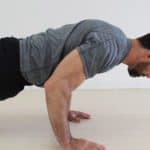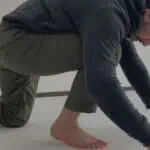You had an injury ages ago. You’re fully healed and the big part of your recovery is behind you.
But if you’re left with some chronic pain, or a new normal post-injury, you’re not out of the game.
You can still make progress. You can still push yourself. And you should aim for getting as close as possible to your previous abilities, even if it takes you longer than you want it to.
As long as you try your best and be smart about your movement, you will only improve in time.
When an Injury Leaves You With Chronic Pain and Limitations
Sometimes, you’re left with sensitivity and less range of motion. This is not unheard of but it’s not a death sentence.
The main thing is you don’t want to get hurt again. The way you stay healthy is by being able to assess and address your own limitations by asking yourself one question:
Are you able to safely attempt the movement?
- If it’s a YES, then you do the movement.
- If it’s a NO, then you’ll want to ease off and see what you can do safely for now.
This could mean you only do part of the movement where you feel safe and in control. For example, if you have knee pain and you know a lunge or full squat is not happening, you can do a quarter squat to a point where it feels challenging.
You can brace yourself by holding onto a chair or a doorway to help you maintain control and balance.
Once you feel it getting hard, pause for a moment, then return back to the starting position. And that’s it. That’s as far as you need to go for this movement. In time, you’ll be able to improve and gauge your progress.
Pain and Discomfort as Realtime Checkpoints
When movements cause pain and discomfort, this is where you need to pay attention. We want you moving in a way that allows progress to be made without putting you at risk for injuring yourself again.
But when you’re dealing with chronic pain from a previous injury, you’re likely going to experience varying levels of discomfort as you work on certain movements.
We like to use a scale of 1-10 as a barometer for how things are going. 1 represents no pain, and is usually where most people are at rest. And 10 is maximum pain, similar to what you felt when you got injured.
We aim for a 3 to 4 on this scale as a limiter for how hard you push yourself. You don’t want to go beyond this threshold on any exercise to keep you from re-injuring yourself. Realize that you’re likely to have some discomfort due to the nature of what it takes to regain strength and mobility in a sensitive area.
But don’t do anything that makes the pain unbearable because that’s likely pushing yourself beyond a point that is therapeutic and might mean hurting yourself again.
Assessing Pain and Soreness as You Make Progress
It’s common to experience some pain and soreness a few hours after the workout, as well as the following day. This is similar to delayed onset muscle soreness (DOMS), but slightly different.
With typical DOMS, it’s deep within the muscles, and is nothing to worry about. You can even train through DOMS, even if it’s slightly uncomfortable.
But with your specific issue, whether it’s your back, knee, shoulder, or another body part that is recovered but still sensitive, you’ll want to be mindful of 2 signs:
- If your pain is similar to the 3-4 scale rating a few hours later or on the following day, you’re going to be okay.
- If your pain is higher than the 3-4 scale rating on the following day and it lingers, you might have overdone your training the day before. This is valuable biofeedback.
If you relate to point #1, you can keep at it, and be mindful of how you perform in the next session.
But if you relate more to point #2, it’s time to reconsider what you did in the previous session, and think about how you can dial it back to prevent being as sore as you are right now.
If this feels like a fine balancing act, that’s because it is. The main thing we want to avoid is the typical boom/bust cycle where you push too hard and end up setting yourself back (bust).
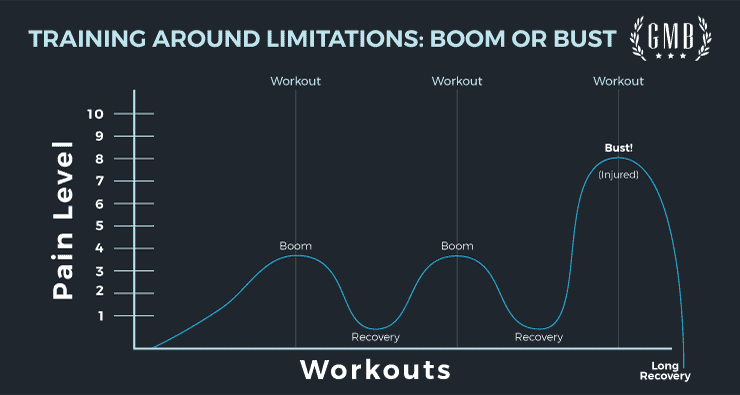
Because if you hurt yourself, again, you’ve just tacked on weeks or months of recovering an injury.
At the end of our program sessions, we have you take a few moments to ponder how the workout went. This is time to reflect on how you did, and to take note of anything that you might change next time.
If you felt like you overexerted yourself, take note. But don’t be fearful. All of this is useful biofeedback that you’re getting in real time.
We want you to be vigilant with what you can do and to consistently push yourself because that’s how progress is made. But don’t get in too much of a hurry because another injury will just set you back.
Focus On What You CAN Do
Let’s say you can safely work up to a 3 out of 10 on the pain scale, but you can’t do the movement exactly how you want to. It’s easy to let yourself get discouraged when you see someone pushing themselves hard because they’ve never been injured.
Or you see someone very strong who makes the movement that you’re working on look easy.
When you compare yourself to others, it’s a sure way to feel frustrated with slower progress.
But who cares? How much better will your life be when you catch yourself doing things you couldn’t do a month ago? Your journey is your own, and it’s not about what anyone else around you is capable of.
Making progress is about constantly checking in and controlling your output while managing the pain you experience during movement.
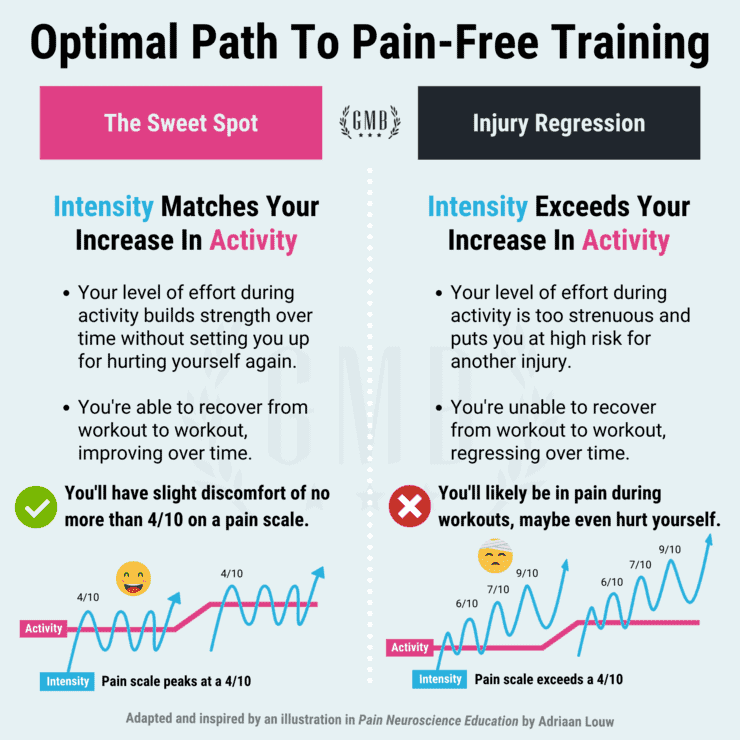
Modifying Movements Based On Your Individual Needs
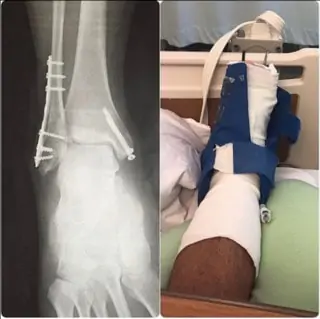 Let’s say you have a limitation that decreases your range of motion. Some examples would be a fused vertebrae, pins in an ankle from surgery, or a tight shoulder from being in a sling while it healed up.
Let’s say you have a limitation that decreases your range of motion. Some examples would be a fused vertebrae, pins in an ankle from surgery, or a tight shoulder from being in a sling while it healed up.
In these scenarios, you’ll have to practice caution and be mindful of how much range of motion you have, as well as a lack of stability and mobility.
Here are some examples, so you can see exactly how to go about modifying the movement based on your limitations:
“I got a bad knee!”
Alright, so let’s say you can’t do a full squat because you get knee pain toward the bottom of the movement.What you can do is modify the squat by grabbing onto a chair, a door frame, or anything that’s stable.
While holding on, you’ll slowly lower yourself to a position that is challenging, but doesn’t exceed a 3 or 4 on the pain scale.
You wouldn’t go lower than what is doable for you on that day.
View this post on Instagram
Over time, you’d continue to practice the modified movement and strengthen the muscles around your knees and work into a deeper squat over the coming months.
“I got a bad shoulder!”
Maybe your shoulder doesn’t have the range of motion it used to and you want to do a handstand eventually.
The way you’d work into this is to start with something that is challenging but doable. It could be using kneeling push-ups as a way to begin loading the shoulders and upper body.
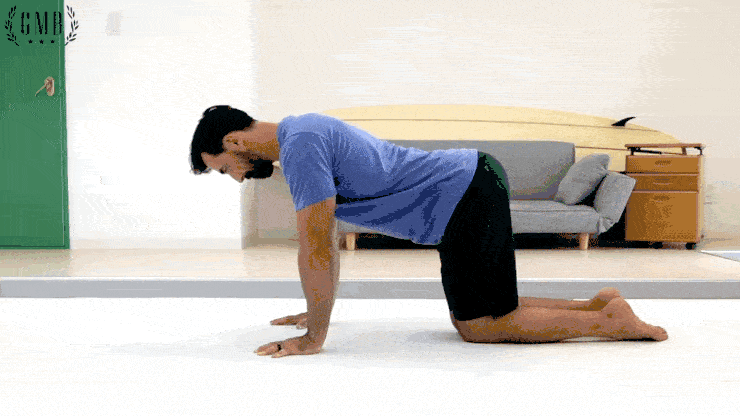
As you get stronger, you’ll be able to work into harder versions of the push-up. And once you’re able to do a full push-up confidently and without any excess pain or discomfort, you’d move onto the first progression of the handstand: the A-frame, which we cover in-depth in Elements.
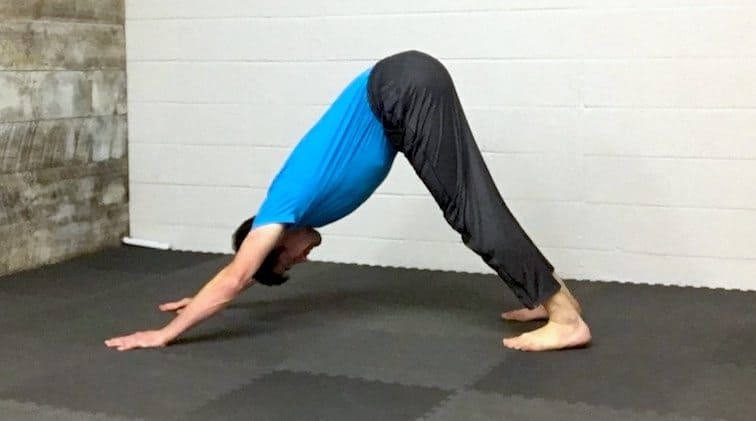
After the A-frame, you’d move onto the next progression and keep going until you’re able to do a handstand.
All of our programs are designed in a way to meet you where you are. And when you use the modified movements, you’ll still be able to make progress at your own pace.
Here, Ryan shows you how to modify movements based on common limitations. 👇
Living Proof You Can Come Back Stronger
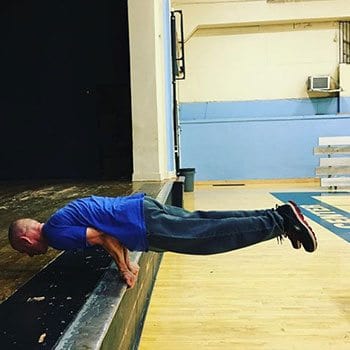 Our client Steve dislocated his shoulder and used Elements to regain his strength and mobility.
Our client Steve dislocated his shoulder and used Elements to regain his strength and mobility.
For him, the gentle movements were helpful in strengthening his shoulders and the surrounding areas. And this type of training was a lot different than all the ‘hardcore’ stuff he’d done in the past.
The mindset portion of the program helped Steve pay closer attention to how his body felt every time he did the program. As a result, he never pushed himself beyond what he could properly do, and respected what his shoulder needed in terms of intensity.
“I came to GMB with a 19 days post shoulder dislocation, hoping by the end of it that I could lift my arm without it hurting… And I can do a full bridge now, no pain. I can do everything I could do before the injury.”
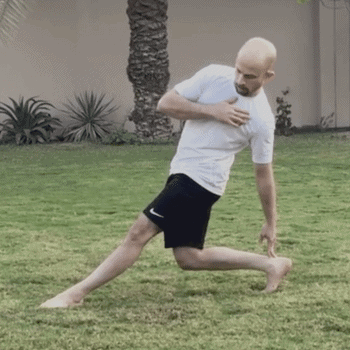 And then, our client Ammar overcame years of being in fear of another injury after an ACL tear by using Integral Strength.
And then, our client Ammar overcame years of being in fear of another injury after an ACL tear by using Integral Strength.
While he knew he needed to be training again, he took a more common bodybuilding approach of lifting heavier weights and getting bigger, but he didn’t feel like he was able to move better, despite getting stronger.
After lots of trial and error with calisthenics and parkour, he found us.
“Integral Strength has a combination of strength and mobility and stretches, and it improved my core a lot, which helped me to be more stable. The program helped me [overcome the cycle of injury I was in] by preparing my body gradually (the joints, tendons, and ligaments, along with the nervous system and muscles) through strength, flexibility, and motor control, and a gradual progression of difficulty and volume.”
Common False Beliefs that Keep You Out Of The Game
Outside of some issues that can put a halt to regular training and movement, here are some common beliefs that hold people back but are completely baseless.
“I have bad knees (or any other body part).”
Now while your pain can be a detriment to moving how you want, having this pain can oftentimes be overcome. This is assuming there are no underlying issues that haven’t been addressed, such as arthritis, muscle tears, or other severe injuries. But even then, you’d be surprised at what you can do with the right approach.
Most of the time when people complain about pain, it can be traced back to a lack of the following:
- Adequate flexibility
- Strength
- General control of their body
For instance, people that complain of hip or knee pain tend to be sitting a lot and not moving their body enough. A way to instantly combat this is to get up from the chair and mobilize more often.
For people with knee pain, a way to deal with this is to strengthen the muscles around the knees, improve hamstring strength and flexibility, and work through moving in a range of motion that is comfortable and expanding on it progressively.
Some people have joints and body parts that are very healthy but they don’t feel great because they’re not actually doing anything. For instance, you might have a healthy set of shoulders, but they hurt all the time because you sit at a desk and don’t ever stretch or strengthen them.’
“I’m over 30, so it’s all downhill from here.”
This one is laughable, but it’s a common belief many people have… that all of the sudden, on their 30th birthday, everything just goes to hell.
The people who believe this tend to have a history of not moving enough and not paying attention to regular exercise. So all the aches, pains, and injuries are a result of lack of movement and mobility throughout their teens and 20’s as opposed to becoming super fragile once they turn 30 (or 40 or 50, and so on).
“I’m not naturally athletic, flexible, or strong.”
A common belief is that if you’re not naturally athletic, you will never be. But what does the athlete have that the common person doesn’t? Outside of some genetic differences (bone mass, height, size, limb length), it’s mostly time spent being athletic. In other words, practice.
They simply had a head start exercising and moving their body.
So the fastest way to crush this belief is to get started and keep going. You can become athletic in your living room if you want. It just takes getting started and having a plan.
We recommend all beginners to start with Elements. After an assessment, you’ll be taken through various movements that will help you build strength and flexibility each week.
“I can’t afford a gym membership” or “I hate going to the gym.”
Perfect. You don’t need a gym to get in a great workout. You don’t need a gym to get stronger, more flexible, and learn how to command some serious control over your body.
All of our programs can be done at home, even in the smallest of spaces. All it takes is that you get started and commit to the effort, even just 15 minutes per session, 3-4 days per week.
“I don’t have time and I get bored easily.”
Could you spend 15 minutes per day working on moving better? Our programs are flexible, and you can choose to spend 15, 30, or 45 minutes for your sessions and we walk you through the entire process.
Limitations are Real, but Significant Progress can be Made by Anyone
Old injuries and changes to your body don’t have to hold you back. Sure, you might have to adapt your approach and be more mindful than the person who’s never been hurt. But what you possess is an awareness of how important it is to take care of the body you have.
We have plenty of clients who’ve worked their way back to being strong again after a setback. Is it time you got started on your journey to a stronger and more capable body?
Overcome Pain and Limitations By Mastering The Basics
With Elements, you’ll build a foundation of strength, flexibility, and control over 8 weeks, setting yourself up for a successful lifetime of staying fit and active.



